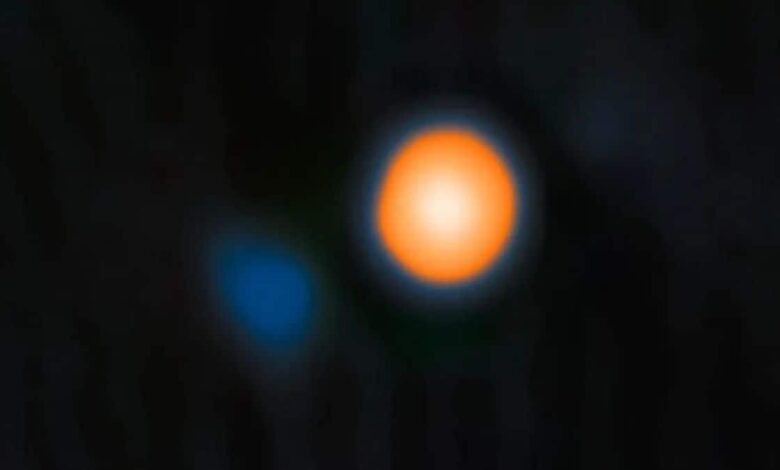Betelgeuse Mystery Solved: Companion Star Spotted!

Betelgeuse’s Secret Companion Star: The Dimming Mystery Solved
For years, astronomers have been puzzled by the unusual dimming of Betelgeuse, the red supergiant star easily visible to the naked eye. Now, the mystery has been solved! Scientists have directly imaged a long-theorized companion star orbiting Betelgeuse, revealing the cause behind its strange six-year dimming cycle. This discovery offers unprecedented insight into stellar evolution and the potential future of this fascinating star system.
The Gemini Telescope’s Breakthrough
The groundbreaking observation was made possible by the Gemini North telescope in Hawaii, utilizing the advanced ‘Alopeke instrument. According to NASA’s announcement, the telescope’s high angular resolution and speckle imaging technique were crucial in piercing through atmospheric distortions and resolving the faint companion star. Previous attempts with the Hubble Space Telescope and Chandra X-ray Observatory had been unsuccessful.
Lead scientist Steve Howell of NASA Ames Research Center emphasized the significance of Gemini’s capabilities in this discovery. The short-exposure imaging allowed them to overcome the challenges posed by Earth’s atmosphere and capture the elusive companion.
Characteristics of Betelgeuse’s Companion
The team’s analysis revealed that the companion star is approximately 1.5 times the mass of our Sun. It maintains a relatively close orbit, residing just four astronomical units (AU) from Betelgeuse – roughly four times the distance between the Earth and the Sun. This makes it the closest detected companion to a red supergiant ever observed, nestled deep within Betelgeuse’s expansive atmosphere.
Scientists believe that the companion star has not yet initiated hydrogen fusion, indicating it’s still in an early stage of stellar development. This difference in evolutionary stage, despite their likely simultaneous formation, sets the stage for a dramatic future.
A Cosmic Cannibalization in the Distant Future?
While both stars likely formed at the same time, their vastly different masses have led to drastically different evolutionary paths. Betelgeuse, a colossal star 700 times the size of the Sun, is rapidly approaching the end of its life. In contrast, the smaller companion star remains relatively young.
This disparity creates a potentially grim scenario. Gravitational forces may eventually pull the companion star into Betelgeuse, a cosmic cannibalization event predicted to occur within the next 10,000 years. This event would dramatically alter the dynamics of the system and could even trigger a supernova.
Implications for Stellar Evolution
The detection of Betelgeuse’s companion not only solves the mystery of its dimming but also provides valuable data for studying stellar evolution in red supergiants. This discovery opens new avenues for understanding the complex interactions within binary star systems and the processes that lead to the eventual demise of massive stars.
Another opportunity to observe the companion star is expected in November 2027, when it reaches its maximum separation from Betelgeuse. Further observations will undoubtedly provide more insights into this fascinating stellar relationship.
Key Findings Summarized
- Discovery: Direct imaging of a companion star orbiting Betelgeuse.
- Cause of Dimming: The companion star’s orbit is responsible for Betelgeuse’s six-year dimming cycle.
- Companion’s Characteristics: 1.5 times the mass of the Sun, orbiting at 4 AU.
- Future: Potential cosmic cannibalization within 10,000 years.
- Significance: New insights into stellar evolution and binary star systems.
Research Details
The findings were published on July 21 across two papers in The Astrophysical Journal. This research represents a significant step forward in our understanding of red supergiants and their interactions with companion stars.
| Feature | Description |
|---|---|
| Star System | Betelgeuse and its companion star |
| Telescope Used | Gemini North Telescope with ‘Alopeke instrument |
| Key Observation | Direct imaging of the companion star |
| Publication Date | July 21 (The Astrophysical Journal) |
Future Research
Future research will focus on further characterizing the companion star’s properties and modeling the potential for a cosmic cannibalization event. Astronomers will continue to monitor the system closely, seeking to unravel more secrets of this intriguing stellar pair.




